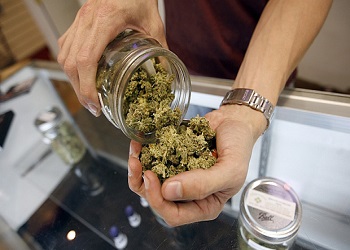In our July 20 Facebook Live session, Senior Editor Mike LaSusa and Geoff Ramsey, a research and communications associate at the Washington Office on Latin America (WOLA), discussed Uruguay’s experience establishing a legal and regulated marijuana market, as well as the implications of this for organized crime and future discussions about drug policy.
The conversation began with Ramsey explaining the most recent milestone in the long-running legalization process: the start of legal sales through pharmacies in Uruguay on July 19.
“As of yesterday, Uruguay is the first and only country on the planet to create a fully-legal and regulated domestic cannabis,” Ramsey said, noting that other countries had only decriminalized the drug at a national level, and that US legalization initiatives have been conducted at the state and not the federal level.
Ramsey explained how the current system evolved from proposals by former President José Mujica that aimed to to implement a state monopoly on the marijuana trade with strict controls and a strong public-health approach. He also outlined some of the details of the current system, including how the marijuana is produced, and how the government closely regulates various aspects of the trade, including the potency and price of the product as well as how much users can access in a given time frame.
SEE ALSO: Uruguay News and Profile
The conversation then turned to what impact these state-supervised marijuana sales could have on organized crime.
Ramsey said that in addition to tight regulation of legal means of accessing marijuana, authorities have already begun cracking down on those still involved in the black market. He argued that authorities are thus aware of and taking steps to mitigate the risk of surplus marijuana from legal production finding its way to the illegal market.
Ramsey and LaSusa also discussed concerns that the structure of the legal market might fail to undercut the illegal marijuana trade in certain respects. Ramsey pointed out that some of the pharmacies sold out on the first day of legal sales, a sign of strong interest in the legal product. And he also argued that the legal drug’s main competitive advantage resides in its quality — which is tested by the government — in comparison to the illegal product that usually originates from neighboring Paraguay, where it is grown and processed on a massive scale and is often of low quality or contaminated with pesticides and other impurities.
This led to discussing one of the experiment’s main objectives, namely undermining organized crime. Both Ramsey and LaSusa agreed that the country has been spared the extreme levels of violence generated by crime groups elsewhere in the region, and that the relatively small size of the Uruguayan market means that the legalization experiment will likely have little impact on regional organized crime. But Uruguay’s legal market could nevertheless offer important lessons about implementing alternative approaches to drug control.
“This is a very important moment to see whether Uruguay’s law can serve as a case study for the potential for marijuana legalization to impact insecurity,” Ramsey said.
SEE ALSO: Coverage of Drug Policy
The conversation ended with an examination of the implications of Uruguay’s legalization experiment on the international drug control regime, which has for decades prioritized prohibitionist approaches to drugs like marijuana.
Indeed, Ramsey highlighted Uruguay’s first-of-its-kind national legal market as another sign of weakening international support for the largely US-led “war on drugs,” pointing to the increasing number of marijuana legalization experiments throughout the Americas in recent years, both by major US states like California and by countries such as Canada and Jamaica.
Watch the Facebook Live broadcast for the full conversation.

